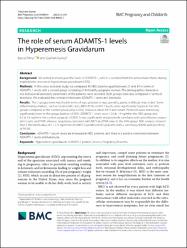The role of serum ADAMTS-1 levels in hyperemesis gravidarum

Göster/
Erişim
info:eu-repo/semantics/openAccessAttribution-NonCommercial-NoDerivs 3.0 United Stateshttp://creativecommons.org/licenses/by-nc-nd/3.0/us/Tarih
2022Üst veri
Tüm öğe kaydını gösterÖzet
Background: We aimed to investigate the levels of ADAMTS-1, which is secreted from the extracellular matrix during
trophoblastic invasion in hyperemesis gravidarum (HEG).
Methods: In this cross-sectional study, we compared 45 HEG patients aged between 21 and 34 in terms of
ADAMTS-1 levels with a control group consisting of 44 healthy pregnant women. The demographic characteristics and several laboratory parameters of the patients were recorded. Both groups were also compared in terms of
ketonuria. We evaluated the correlation between ADAMTS-1 levels and ketonuria.
Results: The 2 groups were matched in terms of age, gestational age, gravidity, parity, and body mass index. Some
infammatory markers, such as neutrophil count, MPV, PDW, and PCT levels, were signifcantly higher in the HEG
groups compared to the control group (all p<0.05). However, mean MCV and serum TSH levels were statistically
signifcantly lower in this group (both p<0.001). ADAMTS-1 levels were 12.6±1.4 ng/ml in the HEG group and
6.2±1.6 ng/ml in the control group (p<0.001). It was signifcantly and positively correlated with urine ketone, neutrophil count, and PDW, whereas negatively correlated with MCV and TSH value in the HEG group. ROC analysis showed
that a threshold value of 11.275 ng/ml for ADAMTS-1 predicted HEG patients with a sensitivity of 60% and specifcity
of 95.5%.
Conclusion: ADAMTS-1 serum levels are increased in HEG patients, and there is a positive correlation between
ADAMTS-1 levels and ketonuria.
Kaynak
BMC Pregnancy and ChildbirthCilt
22Sayı
1Koleksiyonlar
Aşağıdaki lisans dosyası bu öğe ile ilişkilidir:


















